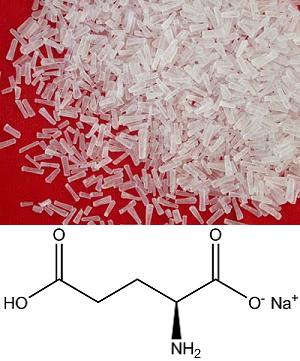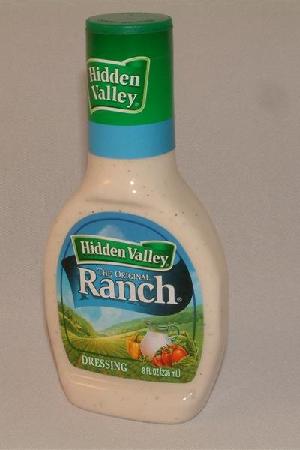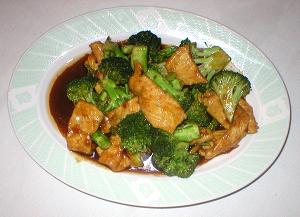The Facts Behind MSG (Plus a Recipe for Chicken & Broccoli)
 | | Monosodium glutamate: delicious gift from the gods, or evil harbinger of pain and destruction? |
The April 1968 issue of the New England Journal of Medicine included an interesting letter from a man named Robert Ho Man Kwok, concerning what he called "Chinese Restaurant Syndrome" (or CRS, as it would later be termed). The man described a variety of symptoms he incurred after eating at Chinese restaurants, including a numbness at the back of his neck, generalized weakness, and palpitations, all of which lasted about two hours without leading to any sort of hangover. One year later, an article was published in Science that blamed monosodium l-glutamate, otherwise known as MSG, a common food additive in Chinese cooking. Immediately following this article's publication, a handful of doctors began asking patients with vague symptomologies whether they had recently eaten Chinese food, sparking a new paranoia that spread like wildfire. The rest is history.
Over forty years later, MSG is greatly stigmatized in the Western world, especially here in America. It isn't uncommon to hear people complain that, if they unwittingly ingest MSG at a Chinese restaurant, they will suffer some ill-effect, be it a migraine, upset stomach, persistent itch, restlessness, etc. Food labels and certain restaurants proudly display if they don't include MSG, in order to assuage the fears of those who believe themselves susceptable to CRS (though few of them know the term). Alas, MSG still appears in unlikely places, and many of the same people who complain of MSG sensitivity will unknowingly have it in their diet.
Meanwhile, back east, MSG is more common than table salt, and is sprinkled on top of almost any prepared food to achieve the taste sensation--now all the rage among western yuppies, hipsters, and culinary students--known as umami. There are no reports of people suffering any ill effects from or intolerance to MSG, not even a single reported case of MSG allergy (an allergy to MSG is as technically impossible as an allergy to water, for reasons I won't get into). Whenever a native of the East moves to the West, he or she will inevitably complain that the food is missing something. As a side note, if you go to a Chinese restaurant and you see lots of Chinese people eating there, chances are high that the chef is sprinkling MSG on the food.
 | | In the interests of full disclosure, this website has not been evaluated by the FDA and may be hazardous to your health |
So who should you believe? Though the FDA mostly cleared MSG of any wrongdoing in 1995, they did find reason enough to suggest labeling foods that contain any form of free glutamate, a suggestion that never became a requirement (because many in the food industry complained that nearly all common foods in America contain trace amounts of free glutamates). Since then, there have been dozens of extensive studies--including peer-reviewed, double-blinded ones (examples: 1, 2, 3, 4)--that demonstrate that reactions to MSG have no statistical difference to those of a placebo, meaning that it is highly unlikely that MSG can be responsible for any physical syndrome. It appears that modern MSG symptom complex is a psychological and sociological phenomenon, not a medical one. I am not trying to dismiss the phenomenon--it is very real for certain people--but I am trying to demonstrate that there is very probably no physical basis for it.
However, this doesn't prevent people from vehemently opposing the usage of MSG on the basis of anectdotal evidence and conspiracy theory. Consider MSGTruth.org, a website wholly devoted to exposing the evils of MSG. This website and its creator, Carol Hoernlein, a former food process engineer and self-proclaimed "food scientist," argue that all research that shows the harmlessness of MSG is funded by a nebulous and omnipotent food lobby. Hoernlein claims that MSG increases histamine reactions for other foods, citing some of the same research she calls into question in other parts of her site. To be fair, there has been one or two studies that demonstrate such an increase, but there have been several others that have demonstrated that this link is nonexistent (besides, an increased histamine reaction would be harmless unless accompanied by food that the consumer is already allergic to and shouldn't be eating anyway). Hoernlein links MSG to everything from the symptoms described by Robert Ho Man Kwok in 1968 to asthma, Alzheimer's disease, the increase in autism diagnoses, and much, much more, while urging people to avoid certain foods that contain free glutamates (including Parmesan cheese, Ranch dressing, chicken, sausage, gravy, packaged chips like Doritos and Cheetos, soy sauce, fish, etc.). There are even places on the website where she claims, in all seriousness, that MSG is equivalent to cocaine and heroin.
 | | Oh God, run away! Don't just sit there; RUN!!! |
Hoernlein and people like her find an interested audience in the Bill Maher and Jenny McCarthy crowd, people who seem eager to believe that anectdotal evidence is far more important than actual scientific studies. After all, you can't trust science because scientists make money and don't care about you. No doubt this very article will spark some controversy in some of the places I post it, and there will be comments from people who offer anectodes about how they or someone they know got deathly ill after eating MSG--either wittingly or not--and that I shouldn't preach all high and mighty, using my tainted science and reason to belittle those suffering from MSG sensitivity.
But why should we care? If there is even a chance that people like Hoernlein are right and that there is a certain percentage of people who have physical problems with MSG and its effects, what's wrong with eliminating it from our food?
For one thing, MSG is delicious. Really, seriously delicious. It activates taste receptors that simply cannot be activated any other way, and adds an indescribable note of flavor to whatever it is added to. A dish that seems to lack something is immediately enlivened by the addition of even a small amount of MSG, and once you experience the difference, you will miss it when it is absent.
Now, I knew all of this before I first added MSG to my own cooking, but I will not lie: I was a little concerned before and after I did. MSG has such a bad reputation that it has embedded itself in our collective consciousness as a bad thing. However, I happily report that I have been using it for months now, and have suffered no ill effects whatsoever. I even talked to my doctor about it.
 | | Chicken + Broccoli + MSG = Yum! |
So, if you're like me and want to try MSG for yourself, I have included a good Chicken and Broccoli recipe below, loosely based on a Broccoli Beef recipe from Martin Yan. You can find MSG in Asian specialty stores and other places (I actually found mine at a dollar store), and what you do is sprinkle a small amount on finished dishes. You don't cook with it, and experts say you don't really need it for dishes with a high concentration of soy sauce or parmesan cheese. If you're planning to add it to a dish that requires adding salt, reduce the salt in the recipe a little. While the below recipe does qualify as having a high concentration of soy sauce, I still find that MSG adds a new dimension to it that you simply can't get without it.
Rather than trust anectdotal evidence, embrace conspiracy theories, or psych yourself paranoid, keep an open mind and try this. You (probably) won't be disappointed.
Takeout-Style Chicken & Broccoli
Approximate cooking time: 35 min
Makes 3-4 servings
Ingredients:
1 lb chicken, cut into thin pieces
2 cups broccoli florets
2 tbsp peanut or vegetable oil
1 cup chicken broth
2 tbsp soy sauce
1 tbsp white wine (Chinese rice wine, if you can find it)
3 tbsp oyster sauce
1 tbsp tamari (dark soy sauce)
2 tsp sesame oil
2 tsp cornstarch
1 tsp minced garlic (2 cloves)
1/8 tsp MSG
1 1/2 cups cooked brown or white rice (brown is healthier)
Directions:
Combine soy sauce, wine, cornstarch, and raw chicken in a bowl. Stir well and let marinate for 10-15 minutes. In a separate bowl, combine oyster sauce, tamari, and sesame oil.
Heat a large skillet over medium-high heat. Once hot, add the peanut or vegetable oil and garlic. Stir until fragrant, about 30 seconds. Add chicken and cook until done (about 3 minutes), stirring frequently. Add the reserved sauce and stir, cooking for another minute. Remove chicken and most of the sauce from pan and turn the heat to high.
Add chicken broth to hot pan, scraping the browned bits from the bottom. Add the broccoli and wait for the broth to come to a full boil. Reduce heat to medium-low and let cook until the broth is almost gone, about 8 minutes, stirring occasionally.
Remove from heat and return chicken and sauce to pan. Add MSG and stir to combine. Serve over rice. |
-e. magill 6/22/2010
|
|